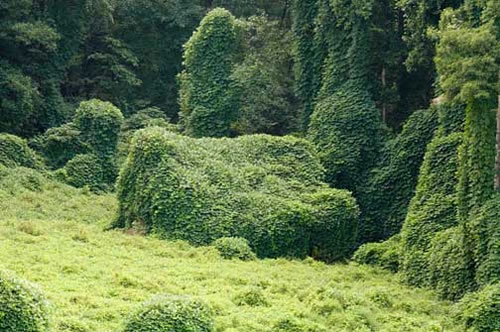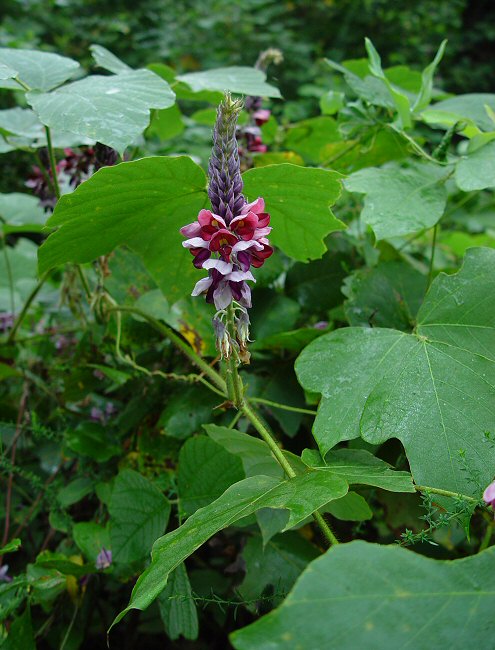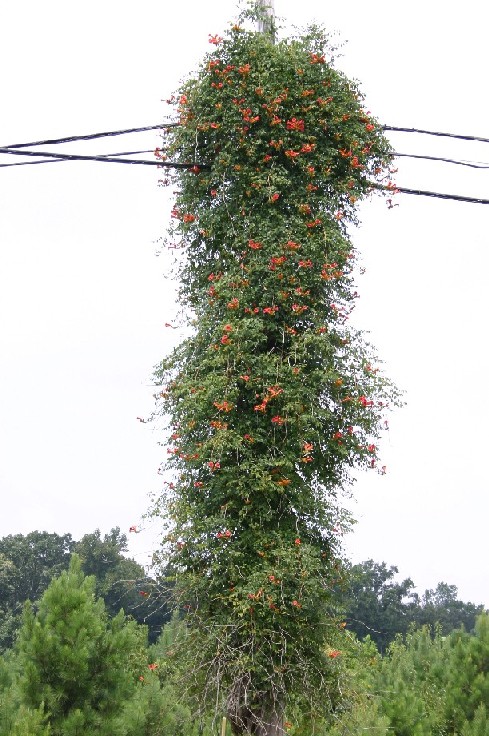What is the best climbing vine to use to cover an open fence?
Not sure where you live but I have a few suggestions: A variety of rambling rose like one pictured below. They look beautiful, the rambling rose is a hardy plant and grows quite quickly and some still have thorns which if you need added protection will give you some security.

They also look beautiful when flowering and smell divine. My vine has grown very well over a couple of years, and I have two varieties growing together so they flower at different times


Again, very hardy, grows quickly and you get produce from it!

Here is a list of Fast Growing Vines For Privacy according to this article by landscaping.suite101.com Here is the link to the article landscaping.suite101.com/article.cfm/fas..." rel="nofollow">landscaping.suite101.com/article.cfm/fas... 1. Honeysuckle Vines ----quote---- Honeysuckle vines are highly desirable vines used for screening and privacy. They are attractive plants and are effective at attracting hummingbirds and desirable insects.
Fast growing and extremely drought tolerant, the dense vines are a sanctuary for bird nests in the spring and will provide screening for privacy in the winter months. ---quote---- Information quoted from landscaping.suite101.com/article.cfm/fas..." rel="nofollow">landscaping.suite101.com/article.cfm/fas... 2. Trumpet Creeper Vines ----quote---- The Trumpet Creeper vine is a fast growing vine which attracts hummingbirds and desirable insects like a magnet.
Unlike the honeysuckle vine, however, the Trumpet Vine is highly invasive and must be constantly kept in check. This vine is long-blooming and its bright red-orange flowers are a beautiful sight to behold in the summer. ----quote---- Information quoted from landscaping.suite101.com/article.cfm/fas..." rel="nofollow">landscaping.suite101.com/article.cfm/fas... 3.
Jackman Clematis Vines ----quote---- The Jackman Clematis vines are one of the more popular types of clematis for the homeowner. The fast growth will cover a trellis or fencing in one growing period and provide a solid carpet of blooms for enjoyment year after year. Colors range from blue to pale pink.
The flowers are an attraction to butterflies and bees and the dense vines provide privacy screening in the winter months. ----quote---- Information quoted from landscaping.suite101.com/article.cfm/fas..." rel="nofollow">landscaping.suite101.com/article.cfm/fas... 4. Sweet Autumn Clematis ----quote---- The Sweet Autumn Clematis derives the name from the profuse blooms produced in the autumn.
This vine grows 10-15 feet per growing season and produces a thick mass of vines that will screen for privacy and noise reduction during the winter months. The sweet aroma of the blooms can be easily noticed from 20-25 feet from the location of the vine, and even farther when the wind is blowing. Bees and butterflies alike are drawn to the sweet and flat white flowers of this beautiful blooming vine.
----quote----- Information quoted from landscaping.suite101.com/article.cfm/fas..." rel="nofollow">landscaping.suite101.com/article.cfm/fas... 5. Artic Kiwi Vine ----quote---- The Arctic Kiwifruit Vine (Antinidia Kilomikta) lives up to the name. It is hardy to -40 degrees F.
This vine is a twining vine that can reach heights of 10 feet or more and the main attraction of the vine is the variegated leaves in the spring season. Each leaf may have the colors of white, green and pink. It is a thick and hardy vine for screening purposes.
----quote---- Information quoted from landscaping.suite101.com/article.cfm/fas..." rel="nofollow">landscaping.suite101.com/article.cfm/fas... 6. Virginia Creeper Vine ----quote---- One of the fastest growing vines, the Virginia Creeper can completely cover a lattice in a matter of weeks. Often mistaken for the common poison ivy plant, this woody vine produces a berry that is eaten by many small animals and birds.
Mice, chipmunks, squirrels, cattle, and deer will munch on the leaves and vines. Although considered invasive in parts of the United States, it is also cultivated as an ornamental in other areas. The plant thrives in partial shade to full sun and tolerates a wide range of soil conditions.It prefers acidic soil.
A rampant grower, this vine can have a climbing height of 60 feet with a spread of over 50 feet. It must be kept in check. ----quote---- Information quoted from landscaping.suite101.com/article.cfm/fas..." rel="nofollow">landscaping.suite101.com/article.cfm/fas... 7.
Euonymus Climbing Vine – Evergreen ----quote---- There are many types of euonymus vines, not all are climbers. The vine is evergreen and gives a dense screening www.landscaping. Suite101.
Com0 is a killer of trees if allowed to grow on them as the dense and vigorous vine will eventually cover the tree’s foliage and prevent photosynthesis. This vine is best confined to a permanent fence structure or trellis. It is highly invasive and must be kept in check.
----quote---- Information quoted from landscaping.suite101.com/article.cfm/fas..." rel="nofollow">landscaping.suite101.com/article.cfm/fas... 8. Wisteria Vine ----quote---- Japanese and Chinese Wisteria Vines are beautiful. They can be invasive, especially in the southern regions of the United States.
For North America, the preferred Wisteria is the American Wisteria vine. It is less invasive and also blooms more quickly. The Wisteria Vine is beautiful in bloom, hardy and will grow quickly and live for many years.
Vines have a place in garden decorating that cannot be replaced by other plants. They have the ability to produce a large amount of flowers in a minimal space. Careful consideration of location, plant needs, and weather conditions must be considered when choosing climbing vines for privacy.
Visiting a local nursery or contacting a local Landscape Architect will provide valuable information, save time, and expense. ----quote---- Information quoted from landscaping.suite101.com/article.cfm/fas..." rel="nofollow">landscaping.suite101.com/article.cfm/fas... Here is a list of the Top 10 gh-Climbing Vines according to www.landscaping. Suite101.
Com1 Please view the link to the article http://home.ivillage.com/gardening/0,,mpb4,00.html 1. Climbing Hydrangea 2. Morning Glory, 'Grandpa Ott's' 3.
Porcelainberry 'Elegans' 4. Sweet Autumn Clematis 5. Morning Glory, 'Heavenly Blue' 6.
Jasmine Tobacco 7. Honeysuckle 'Aureoreticulata' 8. Cup and Saucer Vine 9.
Hop 'Aureus' 10. Trumpet Honeysuckle.
I have a climbing baby rose bush in my backyard that belonged to my grandmother, then my mom and now I hve it. It Is planted next to our big shed in the back and climbs the walls. It is very beautiful and covers a large area.
This site just so happens to have it too, this is the color and style of the baby rose bush that has been in the family for a long time. I found it under "Jackson & Perkins "Zephirie Drouhin Antiue Climbing Rose Bush. jacksonandperkins.com/gardening/PD/02345/ flickr.com/photos/strzelecki1/3666975621/ I also did a sesearch on different climbing bushes and vines and I found some very quick growing very pretty flowers.
They are called Campsis Radicans. They grow and cling onto trees, fences, trellis's, reaching heights beteew 30'and 40'. They are also an excellent choice for a groundcover if you prefer.
They have deep green leaves and bright red-orange long neck flowers and can uphold during a drought. In addition to their beauty they attract Hummingbirds. flickr.com/photos/tanaka_juuyoh/2826351065/ Hope these are of good help!
Sjackson, I took a quick look at your bio, and as a mahalo staff person, I'm going to guess that you're living in the L.A. Area of California. That is considered a Mediterranean climate, and that narrows some of the choice in vines, but those that are available have great characteristics. Just in case you're not there, and are a telecommuter like me, check the hardiness zone map and make sure you choose plants that fit your zone.
cliftyview.com/usda_map.html Some of the vines that others have suggested are coming straight from lists, but not necessarily from actual gardeners. I am a gardener, and I will tell you outright that some of the lists people provided aren't practical. Planting a trumpet vine in many parts of the country is about as bad as planting kudzu in the Deep South.It is a self-inflicted wound, in that it takes over and can literally pull down arbors, pergolas, or small buildings.
(A friend planted trumpet vine in his backyard and it killed out his vitex, a lovely tall shrub, and it just about completely took over his huge walnut trees. ) So trumpet vine (or kudzu) ISN'T a suggestion --they are just examples of what can happen when you plant an alien plant in a place where it has nothing to stop it from taking over. Kudzu run amok:



Plants like morning glories should be banned from ever being planted voluntarily (okay, this is an exaggeration, but if you ever plant it, you'll never get it out of everything it grows into and twines itself to). They grow fast, but those multiple stems you see--they get into everything and while they aren't as huge as kudzu, they'll strangle many of the plants they climb, this is how they compete.

That is one of my favorite spring smells around here in North Texas, and like the wisteria (another spectacular vine) it can take over entire trees and buildings. It's not as heavy as trumpet vine, though. Wisteria can be trained to be a large shrub or a small tree if it is discouraged from climbing.
It takes a lot of work (and it is quite a heavy woody plant). Wisteria


) I had Virginia creeper on my house, but I pulled it down because it was damaging the mortar between the stones and brick. It is absolutely lovely. Like ivy, it's tough, hard to kill, and keeps coming back.
But hard on houses. It would look great on a fence and it does grow fast. Virginia Creeper (5 leaflets on a deeply lobed leaf)

This is in Finland--explorers to America in the colonial days found and took this plant home with them, and it is now found around the world: cliftyview.com/usda_map.html0 cliftyview.com/usda_map.html0 This is a FYI photo - classic Poison Ivy vine and leaves (Rule of 3 - Let It Be! ) In the fall it turns red like a lot of vines. cliftyview.com/usda_map.html1 Clematis is a beautiful vine and there are many carefully propagated and tended cultivars out there.
It can be quite a nice status plant if you are growing one of the very fancy ones. I haven't grown it, but I know it grows here in Texas, so I expect you can grow quite a variety in California. Here is a site with information about clematis: http://clematis.org/learn/page/basics

It can spread, but is easily controlled by hitting the stray bits in the lawn with a mower or a string trimmer. A friend of mine here in Texas had one growing on her cyclone (also called chain link) fence and it was the most beautiful thing I ever saw. And she never watered it--it was a good xeriscape plant (can usually exist like a native plant on natural rainfall, or with infrequent watering).

" They do an English garden, Texas style, but I think you should be able to get some good ideas from their pages if my suggestions didn't do the trick. Vines are a great for creating zones that attract wildlife, so once you get it established, keep in mind that you're setting up a home for any number of small flying, climbing, or crawling creatures. Enjoy!
The Porcelain berry (Ampelopsis) is a fast-pace growing vine that can reach 15 feet within one growing season. It grows best in full sun and with good soil. The vine needs a trellis or support to wrap and twist.
The vine is started by seed or cutting. Although it does flower, most people choose the vine because of its fruit. In the fall the vine produces porcelain blue berries.
I cant really gove you an answer,but what I can give you is a way to a solution, that is you have to find the anglde that you relate to or peaks your interest. A good paper is one that people get drawn into because it reaches them ln some way.As for me WW11 to me, I think of the holocaust and the effect it had on the survivors, their families and those who stood by and did nothing until it was too late.
Related Questions
If you have painted the neighbor's side of a wood fence can the neighbor make you replace it with a new wood fence?
I just bought a house with a pre-exsisting invisible dog fence. How can I find out where the fence is buried?
Is Trump kinda like Superman, where the insults & lies bounce off him while he just keeps climbing....and climbing?
How can you open rusted out cast iron drain trap access cover. I tried wd40 and hammer w wrench but cover will not move 4 inch pipe 1.5 inch wrench acess grip holder for 4 inch cover will heat help?
How to open the plastic cover of amazon kindle ebook with 3G? the cover is so hard to open.....so?
Since the Coverstar™ cover rests on the surface of the water, several inches of accumulated rainwater will be supported by the water under the cover as long as the pool water is maintained correctly. Should Rain Water Be Removed Before Operating Cover?
